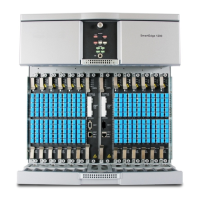Managing Hardware with CLI Commands
5-16 SmartEdge 1200 Router Hardware Guide
Hardware Troubleshooting
Table 5-18 lists the CLI commands that allow troubleshooting individual cards and ports. Required
characters and keywords are shown in bold; arguments for which you must supply a value are shown in
italic.
Table 5-19 lists the loopback types for the commands in Table 5-18 and the ports to which they apply.
Values for CLI Input Arguments
Table 5-20 lists the values for the input arguments in the CLI commands. Values for input arguments that
are shown in bold must be entered in the specified format.
Table 5-18 CLI Commands for Hardware Troubleshooting
Task or Information Needed CLI Command Comments
Clear counters for a port clear port counters slot/port The clear port counters command does not disable the
port; use the shutdown command to disable the port.
Enable loopback on an ATM, an Ethernet,
a Gigabit Ethernet, or a POS port
port port-type slot/port
loopback loopback-type
Disable loopback on an ATM, an Ethernet,
a Gigabit Ethernet, or a POS port
port port-type slot/port
no loopback
Table 5-19 Loopback Types
Loopback Type Description
– No loopback type is specified for Ethernet and GE ports.
internal
1
1. The internal keyword for all ports, except a port on a second-generation ATM OC card, causes all transmitted traffic to be looped back and not sent to the
remote site; instead, the remote site receives a LOS. For a port on a second-generation ATM OC card, the port software injects an alarm indication signal-line
(AIS-L), and then resumes transmitting traffic.
Loops the transmit line to the receive line; ATM OC and POS ports.
line Loops the receive line to the transmit line; ATM OC and POS ports.
Table 5-20 Values for CLI Input Arguments
Argument Range of Values/Description Restrictions
loopback-type See Table 5-19 on page 5-16 for a list of loopback types and the ports
and channels to which they apply.
port 1 to 24, depending on traffic card type. See Table 5-23 on page 5-18 for
the range of ports for each type of traffic card.
The management port on a controller card
is always port 1.
port-type See Table 5-21 for the types of ports.
slot 1 to 6, 9 to 14—The slot in which a traffic card is installed.

